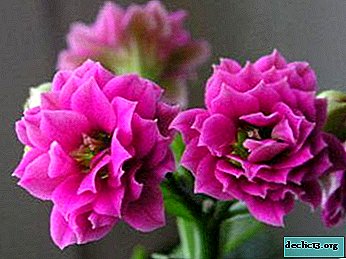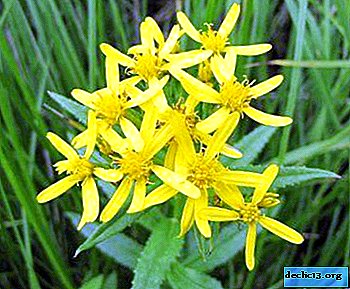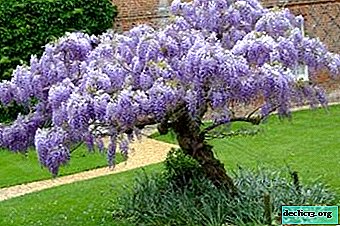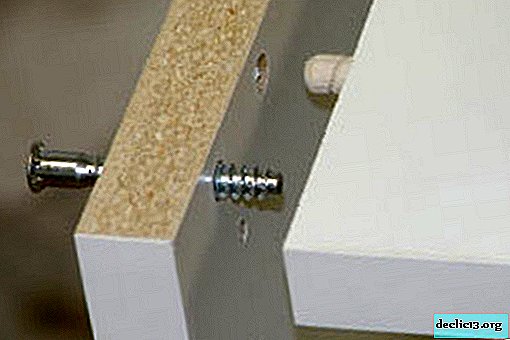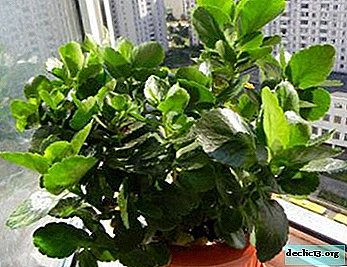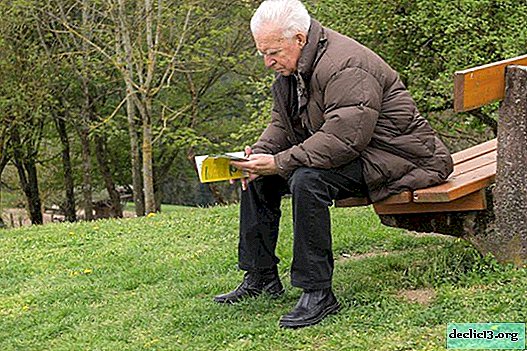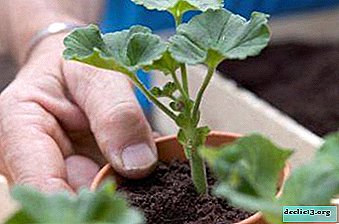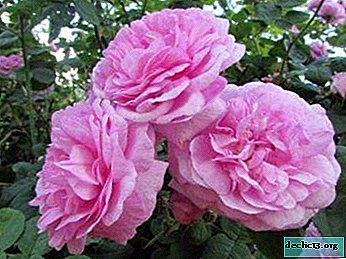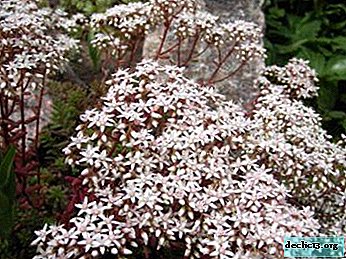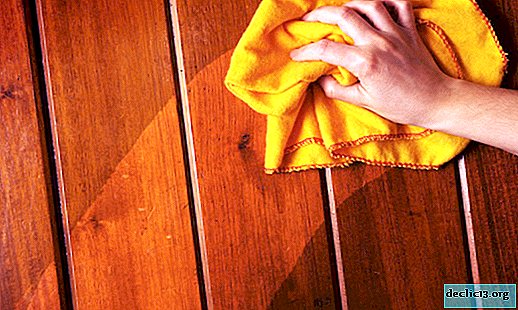Save the life of the plant! Methods for treating balsam from underlying diseases with a photo
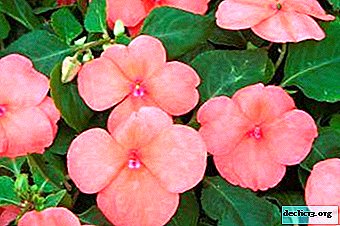 Balsam is loved by many gardeners for its unpretentiousness and appearance.
Balsam is loved by many gardeners for its unpretentiousness and appearance.
He has one drawback - balsam is susceptible to various diseases with improper care.
This article will talk in detail about the causes of diseases, ways of resuscitation, prevention and methods of treatment for this handsome home. And also we can see a diseased plant in the photo.
Plant characteristics
Balsamine is a herb of the genus balsamic. If we turn to the translation of the name, it means "impatient" or "impatient." This name is due to the behavior of the balsam fruits: at the slightest touch, they crack and their seeds fly apart.
Reference. Balsamines can be annuals and perennials depending on the species.Balsam is characterized by the presence of bushy and juicy stems, as well as jagged, whole or lanceolate leaves, and in the complete absence of stipules. The arrangement of leaves can be either whorled or opposite. The color of balsam is green, may vary in shades. The flowers have an irregular shape, can be simple or double.
According to the color scheme, balsam flowers are monochromatic (white, red, yellow) or bicolor. Balsam became popular in Europe in the 16th century and since then remains a favorite among flower growers.
Photo
Here you can see a photo of a diseased indoor flower:

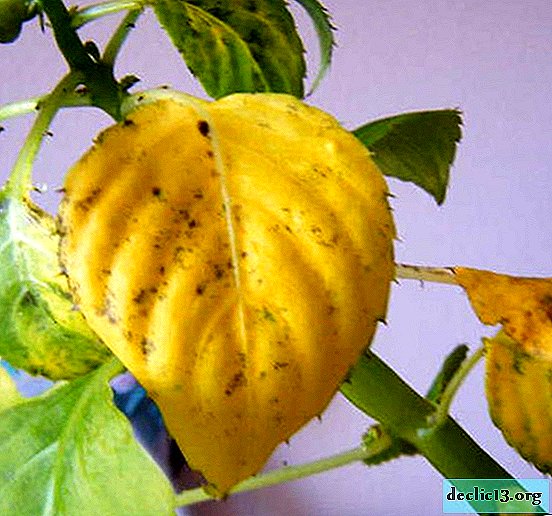


Diagnosis of diseases, causes and ways of their treatment
Why do flowers fall?
So, you find that your wonderful balsam has buds. The complexity of the diagnosis lies in the fact that this ailment can have different causes. The most common causes of falling buds are:
- the presence of pests in the plant, for example, ticks;
- irregular or excessive watering by the plant;
- insufficient humidity;
- improperly selected soil (remember: an incorrect soil ph will greatly inhibit the plant and balsam will not be able to grow normally).
So, when dealing with pests, specialized tools will help you, of which there are now a great many in stores for gardeners and gardeners. Now about the wrong or irregular watering.
Balsam loves humidity, adequate lighting and a warm climate. However, both inadequate and excessive watering can lead to bud dropping.
Important! If you poured the soil of balsam, you must immediately transplant it into another soil, otherwise it will become very sick! When choosing a soil for balsam, consult the store seller so as not to be mistaken with the level of soil acidity.Balsamine needs a certain air humidity, so he gets used to a certain place, creating his own microclimate. Therefore, it is not recommended to transfer the pot with the plant from place to place, balsam will not have time to adapt and flowering will become an insignificant process for it, which means it will lose buds.
How to save if it dries?
 If you find that balsam began to dry, then first of all you need to make sure that the plant is not affected by a spider mite.
If you find that balsam began to dry, then first of all you need to make sure that the plant is not affected by a spider mite.
The spider mite is very tenacious, it is not easy to get rid of the pest, one treatment may not be enough (how to deal with the spider mite on balsam can be found here). It is advisable to carry out treatments three to four times every week until you make sure that you managed to save the plant.
If the problem of drying the plant is not caused by pests, then pay attention to the conditions described below:
- From exposure to excessively dry air, the balsam leaves may begin to dry out, the air in the room where the plant is located should be moderately warm and moderately moist (about why balsam leaves fall and how to solve this problem, read here, and from this article you will learn about why leaves at home balsam and how to help him). If you do not pay attention to it in time, then the balsam will completely dry up, discard almost all the leaves and die.
- It happens that, despite a sufficient level of lighting and heating, a low level of air humidity remains in the room. Balsam can not stand this and immediately begins to dry out. What if he did wilt? In order to overcome the problem, it is necessary to spray water on the leaves of the plant twice a day and constantly monitor its condition.
- Do not forget about the quality of the soil. If a plant lives for a long time in the same soil, then it, having taken all the mineral substances, begins to experience a deficiency in nutrition, as evidenced by drying. If your balsam has long been growing in the same soil, then try changing it and feeding the plant after adaptation.
- Balsam is considered an unpretentious plant, but at the same time it does not tolerate exposure to direct sunlight. It is recommended to place it in partial shade, where balsam can receive sufficient lighting, but will avoid burns, which lead to drying.
The faster you identify the cause, the easier it will be to deal with it., and balsam will again delight you with its unobtrusive beauty and freshness.
In detail about how to treat balsam from diseases and pests, we talked about in our material.
Why do not buds open?
 It happens that balsamins mature, but the buds do not open. The reason for this may lie in the insufficient content of potassium in the soil. In this case, it is advisable to feed balsam with potash fertilizers during the flowering period.
It happens that balsamins mature, but the buds do not open. The reason for this may lie in the insufficient content of potassium in the soil. In this case, it is advisable to feed balsam with potash fertilizers during the flowering period.
The balsam’s middle name is “touchy,” the thing is that he doesn’t like movements, even the usual transfer of the pot from the window sill to the window sill can cause stress and a new period of adaptation in balsam: here, of course, you don’t have to wait for flowering (learn about , why room balsam does not bloom, and only leaves grow, you can here). Therefore, try not to rearrange the balsam during the flowering period.
Balsam is a thermophilic plant, therefore, drafts can quickly destroy this "spark". Just monitor the temperature in the room and avoid drafts, then balsam will delight you with its bright and truly southern flowers (and this is not so small in our climate!)
If it so happened that balsam settled in your place during flowering, be prepared for the fact that the buds will not open (in the worst case, he will completely lose them), this is due to the low stress resistance of the flower and long adaptation.
What if he drooped and darkened at the base?
Having discovered that the balsam began to fade, it wilted and darkened at the base, first of all, there is no need to panic and “bury” the plant: the “black leg” is cured with a patient and competent approach. This ailment affects the plant if the level of humidity of air and soil is greatly increased in the room.
For the treatment of balsam from the "black legs" it is recommended to dry and loosen the soil, it is advisable to sprinkle the soil with wood ash. It is important to adjust the ambient temperature and humidity level. During this period, you can not often water the plant, so as not to aggravate the disease.
Attention! For additional care, you can treat it with a fungicide against fungal diseases, which is sold in flower shops.Balsamine is an unpretentious plant and therefore you have every chance to cure your pet.
What if the flower wilts and dies?
For, to reanimate a diseased plant, it is necessary:
- Conduct soil treatment with appropriate preparations.
- Adjust indoor humidity and soil moisture.
- Eliminate drafts in the room or, conversely, exposure to direct sunlight.
- Get rid of the affected leaves or parts of the plant to enable the balsam to recover.
For the prevention of diseases of indoor balsam, it is necessary to adhere to the following recommendations for home care:
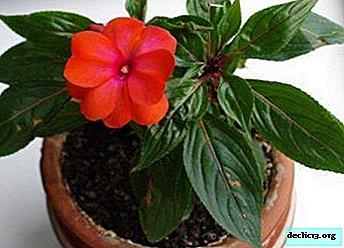 Observe the light mode in the room: Balsamine loves light, but does not tolerate exposure to direct sunlight. Try to find a bright place for the plant with sufficient lighting and sufficient humidity.
Observe the light mode in the room: Balsamine loves light, but does not tolerate exposure to direct sunlight. Try to find a bright place for the plant with sufficient lighting and sufficient humidity.Interestingly, if you are a smoker, balsam will not last long, the plant does not tolerate tobacco smoke.
- Try to maintain a certain temperatureThus, in spring and summer, the temperature comfortable for balsam is 18-26 ° С, and in autumn and winter the temperature should not drop below 16 ° С.
If the air in the room becomes too dry during the heating season, then it is necessary to spray the leaves of the plant with soft water at room temperature, this will moisturize it and increase air humidity. Dry air is detrimental to balsam.
- Maintain optimal balsam watering. So, in summer the plant needs to be watered abundantly, and in winter it is recommended to reduce the amount of moisture. It is important to monitor the condition of the plant and adjust the water balance depending on the circumstances and humidity.
And finally, the tip: in order for the flowering period to last longer, it is recommended to regularly transplant balsam into a substrate for flowering plants (of course, before the flowering phase begins).
Conclusion
Balsam is a wonderful home plant, which, with proper care and patience, even a beginner in floriculture can cope with. Give him a little attention and care, and he will thank you handsomely! Use our tips, and in the future you will not have to save or heal the plant, because balsam will, like a spark, warm your heart for a long time!

 Observe the light mode in the room: Balsamine loves light, but does not tolerate exposure to direct sunlight. Try to find a bright place for the plant with sufficient lighting and sufficient humidity.
Observe the light mode in the room: Balsamine loves light, but does not tolerate exposure to direct sunlight. Try to find a bright place for the plant with sufficient lighting and sufficient humidity.

